The 8/13 Victorian Mounted Rifles was raised as a
CMF Armoured Regiment in May 1948. It formed part of the 2nd Armoured
Brigade which had as its formation sign a black battle axe in an
armoured hand on a yellow background.
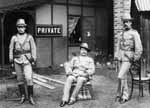 |
The Regiment was part of a lineage dating from 1885
when Colonel Tom Price, on instructions from the government of the
Colony of Victoria formed the Victorian Mounted Rifles, a
mounted militia with companies across the state. |
 |
Contingents
drawn largely from the VMR served in South Africa between 1899 and
1902.
Lieutenant Leslie Maygar won a Victoria Cross while serving with
the 5th Contingent VMR.
Following Federation, the mounted troops
in Victoria were reformed into Light Horse Regiments.
The numbering of
the regiments changed from time to time, but their regional
distribution makes it possible to trace the lineage of the
current regiment.
During WWI three light horse regiments were raised in Victoria for the
AIF, the 4th ALH (see the history of the 4th/19th Prince of
Wales's Light Horse Regiment), the 8th ALH and the 13th ALH.
These
regiments served with distinction at Gallipoli, in the Middle
East and on the Western Front.
|
| C. 1903. A studio portrait of
Lieutenant (Lt) Leslie C. Maygar VC DSO. Lt Maygar was the first
Victorian to be awarded the Victoria Cross. He won his VC at
Geelhoutboom in South Africa on 1901-11-23 serving with the 5th
Victorian Mounted Rifles.
He was awarded the Distinguished Service Order
in 1917-10 whilst commanding the 8th Light Horse Regiment. Lt Colonel
Maygar was killed in action during the battle of Beersheba on
1917-10-31.
|
 |
| This portrait was taken after 1903 and before 1914 as Lt
Maygar is wearing the 1903 Commonwealth pattern full dress uniform. The
'rampant' horse badge of the 8th Light Horse Regiment (a militia badge
pre 1903), the colour patch of the 8th Light Horse Regiment first AIF
(on the left sleeve) and the ribbon of the DSO have been added to the
portrait by the artist. (Donor H. Kerr) |
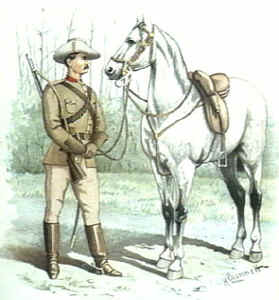 |
- 1885-1890; uniforms, rifle;
dismounted officer of VMR (drawing of uniform is
oversimplified and inaccurate), with horse wearing military
bridle pattern 1885 and officer's saddle, the VMR was a
volunteer body, and members supplied their own horse, saddlery
and uniforms
|
|
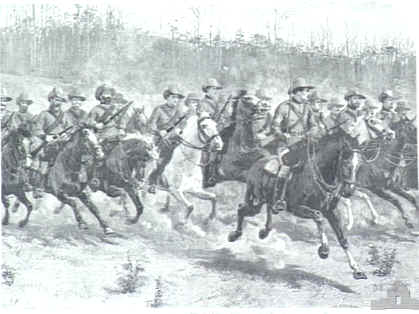
|
|
1889; company of
VMR riding through bushland during training |
|
Charles
Edward Williamson >> enlisted in the 8th Australian
Light Horse Regiment on 8 September 1914, aged 30. A British
subject, he had already served in the Lancashire Hussars and Royal
Welsh Fusiliers. He was promoted to Corporal in 'A' Troop within a
month of joining-up. |
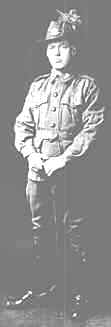 |
The 8th ALH took part in the courageous, but
ill-fated charge at the Nek on 7 Aug 1915.
It later served in
Palestine and Syria as part of the 3rd LH Brigade. On 30 Apr 1917, the
8th ALH charged Turkish positions covering Es Salt, drove the
defenders out and captured the town.
The attackers failed by a few
minutes to capture the HQ of the Turkish Fourth Army, but were
successful in destroying a large quantity of stores and equipment.
|
The 13th ALH was the only complete Australian
LH regiment to serve in France and Belgium. The 13th was the
Corps Cavalry Regiment of the Australian Corps and took
part in every battle involving the Australians. "A" Troop
from C Sqn played a vital role in the recapture of
Villers-Bretonneux on 25 Apr 1918. The Regiment was
prominent in the 1918 battles of Amiens, Albert and the
Hindenburg Line where it was deployed as the advance guard of
the Australian Divisions.
After the war, the Militia in Victoria was
reorganised to reflect the AIF organisation. Regiments were
given territorial titles to foster regional affiliations.
Three of these regiments were the
- 8th (Indi) LH based on NE
Victoria, the
- 13th (Gippsland) LH based in central and east Gippsland,
and
- 20th (Victorian Mounted Rifles) LH based on the
Goulburn Valley and Southern NSW.
These three regiments soldiered through the
years between the wars, maintaining the skills and esprit de corps of
their AIF predecessors. At the outbreak of war in 1939, the 8th,
13th and 20th LH were horse regiments, close to full strength,
and with well trained and experienced officers and men.
|
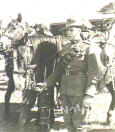
A Trooper from Indi Light Horse.
Note the marksman's badges of crossed rifles and Hotchkiss gunner on
his lower sleeve. (Donor C. Weetman) |
The war brought rapid change. Many of the
officers and men enlisted in the 2nd AIF. As an example, between
March 1940 and January 1941, 575 members of the 700 strong 20th
LH went to the AIF. The regiments put their horses out to graze
and converted to vehicles. By 1943 the three regiments had
become the 8th Cavalry Regiment (AIF), the 13th Armoured
Regiment , and the 20th Motor Regiment (AIF). All were
engaged in the defence of the Australian mainland and were
stationed in Queensland and Northern Territory.
As the direct threat to Australia lessened,
further changes occurred. The 13th Armoured Regt was disbanded and
its members transferred to other units. Similarly in 1944, the 8th Cavalry
Regt was broken up with many of its members going to
Independent Companies and "Z" Force units. The 20th Motor
Regt was retrained as an infantry battalion and in February 1944
posted to Dutch New Guinea where it served till the end of the war.
The 2/8th Armoured Regiment (AIF) was raised
in Victoria in December 1941 as part of the 1st Armoured Division. The
regiment took its title from the 8th ALH which served in
WWI. The Regiment was raised from AIF volunteers, and many
former light horsemen took the opportunity to rejoin a mounted
unit. The first Commanding Officer was Lt Col W G Hopkins who had
commanded both the 13th (Gippsland) LH and 20th (VMR) LH prior
to the war.
The 2/8th Armoured Regt served in northern
Australia and New Guinea. In February 1944, the Regiment
returned to Australia where it was disbanded and converted
by squadrons to Water Landing Craft Companies. The 41st, 42nd and 43rd Aust LC Coys trained in Nth Queensland then served in
Bougainville, Dutch New Guinea and Borneo.
The 8th/13th VMR is a linking of the 8th,
13th and 20th LH Regts. Its title combines the numerical
designation of the first two regiments and the territorial
title of the third, the 20th. The Regiment is the custodian of the guidons of the three regiments which contain battle honours from
the Boer War, WWI and WWII. The regiment's traditional depots
are at Albury, Wangaratta, Benalla and for a period, Cobram.
The Regiment's first Commanding Officer was
Lt Col Tom Fogarty and the first RSM WOI Arch Martin. Both were
former members of the 2/8th Armoured Regt. Other WWII veterans
who joined the Regiment included Major Norman Whitehead
MC, Major Bev McGeoch and Major Reg McDermott. One of those who joined
as a trooper in 1948 was John Neale (ex RAN). Colonel
Neale went on eventually to command the Regiment and finally to
conclude his service in 1992 as Honorary Colonel.
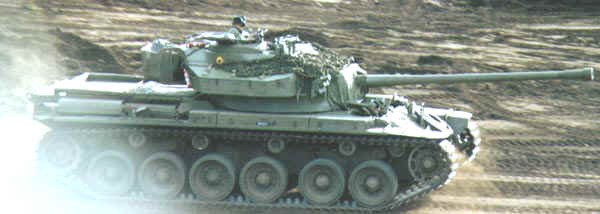
The 8th/13th VMR was initially a tank
regiment equipped with General Grant tanks. In 1957 these were
replaced by Centurion tanks (photo
above).
In 1959, the regiment changed
its role to reconnaissance and was equipped with Ferret,
Saracen, and White scout cars. Through the decades from 1960 the role
of the regiment changed periodically from tank to reconnaissance
to APC, and its major equipment eventually became the M113
tracked vehicles.
In November 1976, the regiment was reduced to
an Independent Squadron: A Sqn 8th/13th VMR, and continued to
train as such till 1992 when it was linked with the
4th/19th Prince of Wales's LH Regiment. The traditions of the
VMR continue to be carried on by the VMR Sqn, 4th/19th PWLH with HQs
at Buna Barracks Albury, the 8th/13th VMR Regimental
Association, and the VMR Museum also at Buna Barracks, Albury.
|










